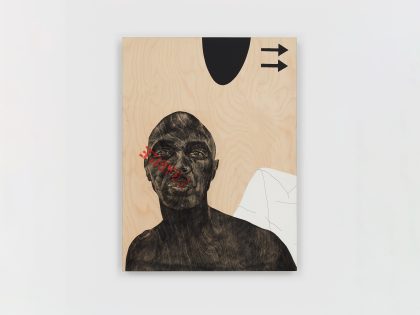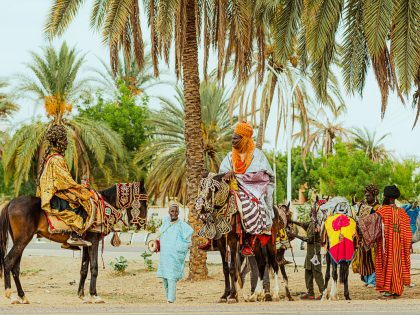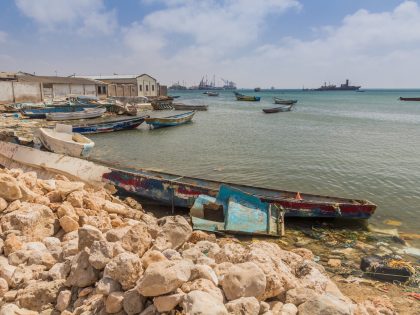The women at the doorway
The photographer Aida Muluneh's work explores Ethiopia via identity, personal journey, and family nostalgia after a 30-year absence.

Woman in Doorway, by Aida Muluneh. All photos in this post by Muluneh.
Aida Muluneh is one of the hardest-working and most talented photographers I have ever met. She breaks the mold and lives in Addis Ababa where she founded D.E.S.T.A (Developing and Educating Society Through Art), an organization that promotes cultural development through the use of photography by providing workshops, exhibitions, and creative exchanges. Her photography book Ethiopia: Past/Forward (Africalia, 2009) explores Ethiopia through the lenses of identity, personal journey, and family nostalgia after a 30-year absence. Her work has been exhibited at the National Museum of African Art in Washington, D.C., and other venues including some in Cuba and Senegal.
…
Aida Muluneh:
It is difficult for me to select my favorite photos because each image I have ever shot, mind you since the age of 16, is embedded in my memory like a reminder of my various developments in photography. However, since the start of my career, I knew that my main obsession was with documenting people as opposed to getting into commercial photography or any other type of photography. When I returned to Ethiopia in 2007, I spent a great deal of time documenting people in their surroundings as they worked, prayed, played, and so forth. I guess in a way I was creating a collection of missing memories of a country that I never knew growing up. Eventually, the images became a book called Ethiopia: Past/Forward, which was a look at my country from a perspective of nostalgia.
Woman at Doorway (Dese, Welo, Ethiopia, 2008): I spent almost a week in the city of Dese, Welo waiting for the rains to pass. It was a frustrating period because it was raining heavily most of the day and the little sun that I could find only came towards the end of my stay in the city. In Dese, I had decided that I would document the Muslim community in the country, so in my month-long tour of the country, I spent a great deal of time looking for Muslims. By coincidence, I was taken to this old woman’s house; she was a widow and had no means of earning an income. Her eyesight was failing and her husband did not leave much behind for her. I entered her humble home and the first thing that I noticed was the fact that she had an egg on her bed. I decided to shoot the bed and as I looked up I saw this amazing ray of light enter her darkened house through the doorway. I asked her if I could take a photo of her and hence, this was the image created.
It was not until after I had loaded the picture on my computer that I saw the beauty, sadness and I am sure the many stories that this woman carries on the lines of her face. I still think about this woman and often wonder how she is doing.
Past/Forward (Addis Ababa, Ethiopia, 2008): Originally the chair that the palace security guards used during the reign of Mengistu Hailmamriam. I found it in the home of Prof. Andreas Eshete and thought it symbolized basically the story of a generation. The rule of the Dereg under the leadership of Mengistu Hailmamriam was a period for us that was marked by the massive exodus of a population in order to escape the oppressive system.

This chair to me is fascinating in the sense that whoever was using this chair decided that instead of painting over the Emperor’s emblem (you can see the crown and cross), they chose to stencil the communist symbol of the sickle and hammer.
The Road to the Art School (Addis Ababa, Ethiopia, 2008):
When I first arrived in Addis Ababa in 2007, one of the first things that I did was teach photography to a group of art school students. In their first week of the workshop, they spent a few days shooting along the road that led to the art school, which is part of Addis Ababa University. This small side road that is marked by cobblestones was a shortcut for many of the students and they had an interesting relationship with the community.

Over the years I have seen the neighborhood kids growing up and the various old residences still walking back and forth on this road. In this image, the shadows are the students along with myself and the little kid who came out of nowhere chasing a ball. I took the shot because I like the shadows but later on, in retrospect, I realized the kid reminded me much of my first son.
The Look (Addis Ababa, Ethiopia, 2008): Sometimes when you are shooting, you have to expect the unexpected. This is one of the funniest images that I have in my collection because it is a statement about who we are as a group of people. I cannot remember the full details of the event but it was a performance that took place at Asni Gallery a few years back.

The invited guests came from Sweden and gave various performances in the gallery. When this man came, I could see the looks of the audience because he was wearing high heels along with this outfit. As he did his performance, people were trying to comprehend the whole situation. After he completed his piece, he walked out and it was at this moment that I took this photo. For me there are many things in this image that symbolizes the country. The fact that the guy is wearing a traditional shirt that says Ethiopia, his suspicious glance, and the fact that he is standing at a doorway. Need I say more?



















